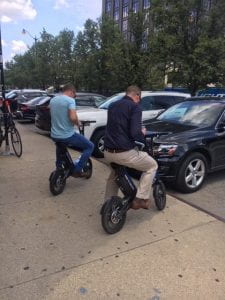Chicago’s e-scooter pilot program, which is set to run through mid October, is one of this summer’s hottest transportation stories. Ten operators were authorized to operate up to 250 e-scooters apiece west of Halsted Street and the Kennedy Expressway. Nationally, the buzz for this new mobility option has been going for some time now, and the transport mode certainly has its fans and detractors. But, now that e-scooters can finally be found zipping around our city, the Chaddick Institute wanted to check in on the first two months.
By agreement, the e-scooter companies had to make their data streams public, so, we picked a day (July 24, to be exact) and analyzed “A Day in the Life of Chicago’s E-Scooter Pilot Program” – the title of the latest Chaddick Institute report. Here’s a bit of what we discovered…
 When the conversation isn’t charged up with stories of e-scooters in trees or bodies of water, a major point of focus is the potential “first mile/last mile” mobility benefits that this new mode could bring (especially for transportation buffs like us). Using a sophisticated time of day analysis, our expert, Scott Smith, found strong evidence that Chicagoans are in fact commuting via e-scooter, with the morning rush busier than the evening rush. Many are likely using scooters to reach transit stops.
When the conversation isn’t charged up with stories of e-scooters in trees or bodies of water, a major point of focus is the potential “first mile/last mile” mobility benefits that this new mode could bring (especially for transportation buffs like us). Using a sophisticated time of day analysis, our expert, Scott Smith, found strong evidence that Chicagoans are in fact commuting via e-scooter, with the morning rush busier than the evening rush. Many are likely using scooters to reach transit stops.
One finding isn’t up for debate – Chicagoans like to scooter! We measured that there were over 2,500 unique trips over our 12-hour study period. Another interesting aspect of the research is that e-scooters are being used in that scenario where it’s just a bit too far to walk and just short enough that waiting for the CTA also doesn’t make much sense. We found that the average trip was about two miles, based on reasonable assumptions regarding how long they sit idle before moving again.
Finally, the pilot included provisions for two priority areas where access to transit and household incomes tend to be lower in the western half of the zone; in these zones, operators are required to keep half of their scooters in the two zones. Are the e-scooter providers complying? Yes. While the percentage of scooters in the priority zones drops during the day to about 48%, it peaked at 52.8% around 8:38am on July 24. In short, coverage in the priority areas is relatively good, but there appears to be more work to be done.
With two months left in the e-scooter pilot, the Chaddick team will continue to monitor the newest transportation mode to hit our streets. What do you think – e-scooters…friend or foe? Post your thoughts or experience below, we’d love to hear what you think!

It’s too bad to check your article late. I wonder what it would be if we met a little faster.
I want to exchange a little more, but please visit my site and leave a message!!
제이나인 온라인 카지노 먹튀
제이나인 해외 온라인 카지노
제이나인 온라인 카지노 사이트 추천
제이나인 안전한 온라인 카지노
제이나인 온라인 카지노 조작
https://www.j9korea.com
I checked the status of Chicago’s e-scooters a couple minutes ago. It appears that deployment is holding steady at around 1,640 scooters (+ Veoride). Chaddick is planning to collect data over the final two weeks of the program in order to examine system performance for a bit longer period of time (stay tuned for related Chaddick Insights blog post). I’m hoping the city will compile their own, perhaps more comprehensive, data and analysis into a summary report this fall. Also, if anyone out there is interested in acquiring the “day in the life” dataset, feel free to email your request to c.scott.smith@depaul.edu.
E-scooters add a viable alternative for quick and easy transportation in the city, but unfortunately they are not accessible to everyone. As a daily commuter, I am always seeking new ways to reduce my travel time, from the moment I step on the Metra, to the 1-mile walk from Union Station to my office building. The 1-mile distance is not worth waiting for a bus or train, and while it is walk-able, it is not time-efficient. Hopefully e-scooters will remain a friend of the city, perhaps through a long-term pilot program, and provide greater coverage throughout the entire city!